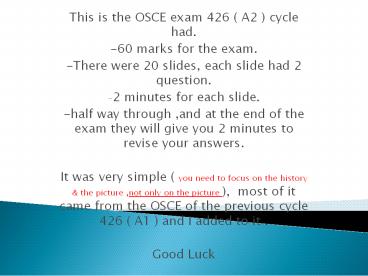This is the OSCE exam 426 ( A2 ) cycle had. - PowerPoint PPT Presentation
Title:
This is the OSCE exam 426 ( A2 ) cycle had.
Description:
This is the OSCE exam 426 ( A2 ) cycle had.-60 marks for the exam.-There were 20 s, each had 2 question. 2 minutes for each .-half way through ,and at ... – PowerPoint PPT presentation
Number of Views:159
Avg rating:3.0/5.0
Title: This is the OSCE exam 426 ( A2 ) cycle had.
1
- This is the OSCE exam 426 ( A2 ) cycle had.
- -60 marks for the exam.
- -There were 20 slides, each slide had 2 question.
- 2 minutes for each slide.
- -half way through ,and at the end of the exam
they will give you 2 minutes to revise your
answers. - It was very simple ( you need to focus on the
history the picture ,not only on the picture ),
most of it came from the OSCE of the previous
cycle 426 ( A1 ) and I added to it . - ??????? ??????
- Good Luck
2
- Unfortunately I couldnt find the exact picture
but it was similar to this - Q. What is this instrument
- A. Pinhole
3
A
B
- Q. Identify the organ (A)
- A. Superior canaliculus.
- Q. Identify the organ (B)
- A. Nasolacrimal sac.
4
- Unfortunately I couldnt find the exact picture
but it was similar to this - Q. What is the diagnosis?
- A. Right facial (7th) nerve palsy (LMNL).
- Q. Mention 2 ocular manifestations of this
condition. - A. Exposure keratitis, epiphoria (excessive
tearing), ectropion.
5
It was the exact picture. A YZ11D direct
ophthalmoscope.
- Q. What is the magnification?
- A. x15 (not sure about this really).
- Q. Mention 2 characteristics of the image
produced. - A. Right image (not inverted), mono-ocular
vision, high magnification, narrow area.
6
- This was a bilateral finding in a young obese
woman with 120/80 BP. CT scan imaging was
negative. - Q. What is the most likely diagnosis?
- A. Pseudotumor cerebri (some students said that
we were asked for the finding not the diagnosis
and therefore wrote papilledema). - Q. How would you manage her?
- A. 1.Medical weight reduction and
carbonic-anhydrase inhibitors (e.g.
acetazolamide) - 2.Surgical CSF shunt.
7
- Unfortunately I couldnt find the exact picture
but it was similar to this - Q. What is the diagnosis?
- A. Central retinal vein obstruction (CRVO).
- Q. Mention 2 predisposing factors.
- A. HTN, diabetes, atherosclerosis, etc.
8
- Q. What is the diagnosis?
- A. Accommodative esotropia in the right eye.
- Q. Which type of refractive error is associated
with this condition? - A. Hyperopia.
9
- This picture came exactly
- Q. What is the refractive error illustrated in
the diagram? - A. Hyperopia
- Q. What type of lenses could be used to correct
it?
10
- Q. What is the diagnosis and Sign?
- A. Proliferative diabetic retinopathy (PDR).
- ( Fan sign )
- Q. How would you manage this patient?
- A. Pan-retinal photocoagulation (PRP) and control
blood sugar.
11
- Unfortunately I couldnt find the exact picture
but it was similar to this - A 2 year old child presented with this condition
- Q. What is this sign?
- A. Leucokoria in the right eye.
- Q. Mention 2 differential diagnoses.
- A. Congenital cataract, retinoblastoma.
12
- Unfortunately I couldnt find the exact picture
but it was similar to this - A patient with a history of sudden painless
redness in the eye - Q. What is the diagnosis?
- A. Subconjuctival hemorrhage.
- Q. Mention 2 causes of this condition.
- A. Trauma, blood coagulopathies, anti-coagulants
(OCP), cough, valsalva maneuver, old age,
idiopathic.
13
- A patient with a history of glaucoma
- Q. What is this sign?
- A. Cupping (increased cupdisk).
- Q. Which type of visual field defect is
associated with this condition? - A. Peripheral visual field defect.
14
- A 25 year old patient with a history of sinusitis
and fever - Q. What is the diagnosis?
- A. Orbital cellulitis.
- Q. How would you manage her?
- A. Admission, temperature chart, culture and
sensitivity, IV antibiotics, CT scan.
15
- A patient with a history of wearing contact
lenses - Q. What is the diagnosis?
- A. Corneal ulcer.
- Q. How would you manage this patient?
- A. Remove the contact lenses and topical
antibiotics.
16
- Unfortunately I couldnt find the exact picture
but it was similar to this - Q. What is the diagnosis?
- A. Herpitic keratitis.
- Q. What is the name of the stain that was used?
- A. Fluorescein dye.
17
- Unfortunately I couldnt find the exact picture
but it was similar to this - A 60 year old patient with a history of blurred
vision - Q. What is the diagnosis?
- A. Senile cataract.
- Q. Mention 2 postoperative complications for this
condition. - A. Endophthalmitis, hemorrhage.
18
- A patient with a history of cataract surgery
- Q. What is the diagnosis?
- A. Endophthalmitis.
- Q. How would you manage this patient?
- A. Administer intravitreal antibiotics.
19
- Unfortunately I couldnt find the exact picture
but it was similar to this - A patient with a history of an operation done in
the iris - Q. What is this procedure called?
- A. Peripheral iridotomy.
- Q. What is the indication of this procedure?.
- A. Acute closed angle glaucoma, narrow angle
glaucoma.
20
- Q. What is the diagnosis?
- A. Right oculomotor (3rd) nerve palsy.
- Q. If patient has a history of nausea, vomiting
and dizziness. What will be the most likely
diagnosis? - A. Neoplasm (brain tumor).
21
- Q. What is the diagnosis?
- Vitrous Hemorrhage
- Q. Name 3 causes
- Trauma, HTN , DM































